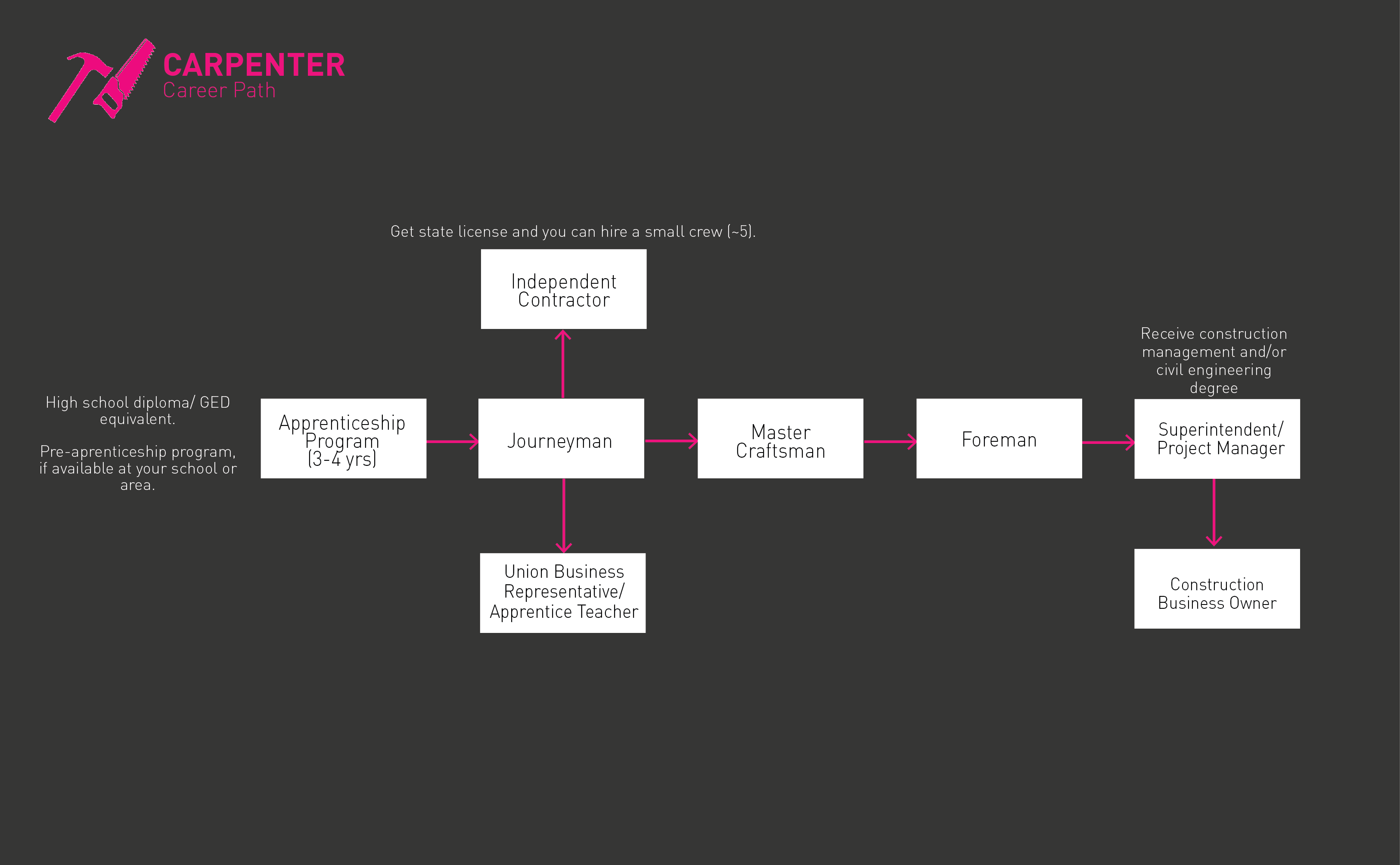Focos
Carpintero de puentes, ebanista, carpintero, carpintero de hormigón, carpintero de construcción, carpintero de encofrados, carpintero de estructuras, carpintero de mantenimiento, carpintero de obra gruesa, constructor de andamios.
Los carpinteros construyen y reparan estructuras y armazones de edificios hechos de madera y otros materiales.
- ¡Puedes construir cosas y trabajar con tus manos!
- Movilidad: Si estás afiliado al sindicato, hay varios clubes locales en todo el país. Así que si te mudas a otra ciudad, puedes inscribirte en la lista de desempleados y recibir llamadas para trabajar.
- Flexibilidad: tú decides cuánto quieres trabajar. Tú creas tus propias vacaciones. No hay vacaciones de dos semanas.
«Eres capaz de ver el mundo de otra manera. Sabes cómo hacer cosas, diseñar cosas, crear cosas... Cuando compré mi casa, rediseñé mi propio cuarto de baño. Te sientes empoderado. Puedes crear y construir de forma habitual». SilviaY. Ledezma, carpintera oficial, constructora de andamios (plataformas), condado de Contra Costa.
- Sigue los planos y los proyectos de construcción para satisfacer las necesidades de los clientes.
- Instala estructuras y accesorios, como ventanas y molduras.
- Mide, corta o da forma a madera, plástico, fibra de vidrio, paneles de yeso y otros materiales.
- Construye estructuras de edificios, incluyendo montantes de paredes, vigas de suelo y marcos de puertas.
- Ayuda a montar, nivelar e instalar estructuras de edificios con la ayuda de grandes poleas y grúas.
- Inspecciona y sustituye estructuras y elementos fijos dañados.
- Instruye y dirige a los obreros y otros ayudantes del sector de la construcción.
Residencial
- Trabaja en la construcción y remodelación de viviendas nuevas, casas adosadas y condominios.
- Ejemplos de tareas: Construye y coloca encofrados para cimientos, paredes, techos y terrazas; arma estructuras para paredes interiores, construye escaleras e instala paneles de yeso, molduras, puertas y gabinetes de cocina.
Comercial
- Trabaja en la construcción y remodelación de edificios de oficinas comerciales, hospitales, hoteles, escuelas y centros comerciales.
- Ejemplos de tareas: Trabaja con estructuras de acero ligeras y portantes para tabiques interiores, estructuras exteriores y construcción de muros cortina.
- Los carpinteros comerciales suelen poder realizar también las tareas de los carpinteros residenciales.
Industrial
- Trabaja en entornos civiles e industriales, donde instala andamios y construye y coloca encofrados para verter hormigón. Ejemplo: túneles, puentes, centrales eléctricas o proyectos de construcción de alcantarillado.
- Ejemplos de tareas: Construye refuerzos para túneles o tabiques en pasajes subterráneos y minas para controlar la circulación del aire en los lugares de trabajo.
- Destreza manual: hábil con las manos.
- Coordinación mano-ojo
- Pensamiento crítico y resolución de problemas: te enfrentarás a problemas inesperados y tendrás que resolverlos rápidamente.
- Matemáticas básicas: aritmética, álgebra, geometría, cálculo y estadística.
- Conocimientos informáticos: planificación de proyectos, software de estimación.
- Atención al detalle
- Fuerza física y resistencia
- Puede ser peligroso porque se trabaja con objetos afilados y a gran altura.
- Sin estructura: tienes que gestionar tu dinero y tu tiempo porque el trabajo se basa en proyectos. Cuando terminas un proyecto, puede pasar algún tiempo hasta que consigas otro. Es necesario gestionar el tiempo y las finanzas con prudencia.
- Si te gusta la estructura y te gusta cobrar cada dos semanas, entonces este no es el trabajo para ti. Pero si quieres flexibilidad, establecer tu propio horario, entonces esta es una excelente opción profesional.
- ¡Construir, crear y arreglar cosas!
- Estar al aire libre, en contacto con la naturaleza.
«Soy artista desde los 17 años y siempre me ha gustado trabajar con las manos: cortar, montar marcos...». SilviaY. Ledezma, carpintera oficial, constructora de andamios (escenarios), condado de Contra Costa.
- Protección: salarios, discriminación, accidentes laborales.
- Lista de trabajos pendientes
- Beneficios
- Salario más alto: horas extras, doble tarifa.
- Jubilación (dependiendo del sindicato): Después de 5 años, en algunos oficios/sindicatos, se adquieren derechos y se tiene derecho a la contribución paralela de la empresa. Después de 30 años, se adquieren derechos completos sobre el 100 % del salario.
- Los carpinteros aprenden su oficio mediante el aprendizaje y la práctica. Se necesita un título de secundaria/GED, pero no es necesario tener un título universitario.
- Algunos estudiantes completan un título de técnico superior en carpintería en un centro de formación profesional o una escuela vocacional.
- Las asociaciones sindicales y de contratistas gestionan los programas de aprendizaje pertinentes (consulte nuestros Recursos recomendados > Sitios web para obtener más detalles).
- La formación práctica adquirida a través de la experiencia laboral es fundamental. Los carpinteros principiantes comienzan con tareas básicas, aprendiendo bajo la supervisión de un profesional experimentado.
- Las áreas comunes de aprendizaje incluyen la lectura de planos, matemáticas básicas, códigos de construcción, principios de seguridad y primeros auxilios.
- También es necesario realizar la formación básica en seguridad de la Administración de Seguridad y Salud Ocupacional (OSHA).
- La formación especializada adicional puede abarcar el trabajo con hormigón, soldadura, aparejos y andamios, y protocolos para espacios confinados.
- Existen docenas de opciones de certificación especializada de organizaciones tales como:
- Instituto de Puertas y Herrajes
- Alianza de la Industria de Ventanas y Acristalamientos
- Certificación de Empresas Ecológicas S.A.
- Asociación Nacional de Constructores de Viviendas
- Asociación Nacional de la Industria de la Remodelación
- Centro Nacional para la Educación y la Investigación en Construcción
- Asociación Nacional de Suelos de Madera
- Asociación de la Industria de Andamios y Acceso
- Instituto del Revestimiento Vinílico
- Edad mínima de 18 años.
- Educación secundaria o equivalente.
- Físicamente capaz de realizar el trabajo.
- Ciudadano estadounidense o prueba de residencia legal.
- Superar la prueba de detección de abuso de sustancias.
Haga clicaquípara encontrar su centro de formación de aprendices más cercano.
- Toma cursos en la escuela secundaria como taller, matemáticas, álgebra, geometría, física y dibujo técnico.
- Adquiera el hábito de practicar buenas medidas de seguridad y de usar el equipo de protección personal adecuado.
- Si es necesario, comience un programa de ejercicios o practique educación física para asegurarse de tener la fuerza y la resistencia necesarias para realizar trabajos de carpintería a tiempo completo.
- Obtenga su permiso de conducir para poder desplazarse a los lugares de trabajo cuando sea necesario.
- Solicita puestos de trabajo como peón de construcción para adquirir experiencia práctica.
- Participa como voluntario en proyectos de construcción locales de Hábitat para la Humanidad para aprender sobre materiales, métodos y herramientas. ¡Considera oportunidades en el extranjero para una experiencia aún más emocionante!
- Criterios de revisión para conseguir un puesto de aprendiz de carpintero en tu zona.
- Estudia libros, artículos y tutoriales en vídeo relacionados con el oficio.
- Pregunta a un carpintero con experiencia si puede ser tu mentor.
- Guarda un borrador de tu currículum, anotando cualquier habilidad que hayas adquirido, proyectos completados y otros detalles.
- Obtenga una certificación en un área especializada para reforzar sus credenciales.
- 43,4 % con título de secundaria
- 5,1 % con título de asociado
- 6,1 % con título universitario
- 0,9 % con máster
- 0,3 % con Professional

- Los programas de aprendizaje de carpintería son la mejor manera de entrar en este sector.
- Busca anuncios de empleo en portales de empleo como Indeed, Simply Hired, Glassdoor y Zippia, así como en Craigslist para oportunidades locales más pequeñas.
- Lea atentamente los requisitos y asegúrese de que cumple todos los criterios necesarios.
- Comunícate con tu red de contactos para que todos sepan que estás buscando trabajo.
- Visita los sitios web de las empresas locales que contratan carpinteros. Busca ofertas de trabajo que quizá no aparezcan en otros sitios.
- ¡Sé proactivo! Considera llamar a algunas empresas para hacer preguntas sobre los programas de formación profesional.
- Si asistes a una universidad o escuela profesional, pide ayuda al centro de orientación profesional para redactar tu currículum y practicar para las entrevistas.
- Muchos programas profesionales y de formación profesional sirven como conductos para los reclutadores locales, así que ¡háblales cuando estés listo para trabajar!
- Revisa las plantillas de currículum de carpintero para obtener ideas sobre la redacción y los formatos.
- Asiste a ferias de empleo locales para hablar con los reclutadores y compartir tu currículum.
- Habla con tus profesores y antiguos supervisores sobre su disposición a servir como referencias personales.
- ¡Estudia las preguntas de la entrevista de Carpenter para prepararte para las entrevistas!
- ¡Esfuérzate!: No dependas solo de la lista de desempleados. Asiste a los eventos del sindicato local. Establece relaciones con el capataz. Sé proactivo.
- Ser capaz de comunicarse con su equipo.
- Sé curioso y aprende constantemente los nuevos avances (software, técnicas, noticias) de la profesión.
- Habilidades lingüísticas: Saber español es una gran ventaja.
Sitios web
- Aprendizaje.gov
- Constructores y contratistas asociados
- Contratistas Generales Asociados de América
- CareerOneStop
- Departamento de Trabajo, Administración de Empleo y Formación
- Instituto de Puertas y Herrajes
- Alianza de la Industria de Ventanas y Acristalamientos
- Certificación de Empresas Ecológicas S.A.
- De cascos a cascos de seguridad
- Instituto de Constructores de Viviendas
- Asociación Nacional de Constructores de Viviendas
- Asociación Nacional de la Industria de la Remodelación
- Sindicato Nacional de Oficios de la Construcción
- Centro Nacional para la Educación y la Investigación en Construcción
- Asociación Nacional de Suelos de Madera
- NCCER
- Administración de Seguridad y Salud Ocupacional
- Asociación de la Industria de Andamios y Acceso
- Hermandad Unida de Carpinteros
- Instituto del Revestimiento Vinílico
Libros
- Libro de ejercicios de carpintería moderna, por Willis H. Wagner, Howard Bud Smith, et al.
- El carpintero muy eficiente: Estructuras básicas para la construcción residencial, por Larry Haun
- Planes y proyectos de carpintería: la guía paso a paso, por Anthony Deck
Fuente de noticias

Empleos destacados

Cursos y herramientas en línea

Expectativas salariales anuales
Los nuevos trabajadores comienzan con un salario de alrededor de 63 000 dólares. El salario medio es de 77 000 dólares al año. Los trabajadores con mucha experiencia pueden ganar alrededor de 82 000 dólares.
Expectativas salariales anuales
Los nuevos trabajadores comienzan con un salario de alrededor de 61 000 dólares. El salario medio es de 77 000 dólares al año. Los trabajadores con mucha experiencia pueden ganar alrededor de 100 000 dólares.
Expectativas salariales anuales
Los nuevos trabajadores comienzan con un salario de alrededor de 56 000 dólares. El salario medio es de 68 000 dólares al año. Los trabajadores con mucha experiencia pueden ganar alrededor de 83 000 dólares.
Expectativas salariales anuales
Los nuevos trabajadores comienzan con un salario de alrededor de 63 000 dólares. El salario medio es de 82 000 dólares al año. Los trabajadores con mucha experiencia pueden ganar alrededor de 105 000 dólares.
Expectativas salariales anuales
Los nuevos trabajadores comienzan con un salario de alrededor de 58 000 dólares. El salario medio es de 66 000 dólares al año. Los trabajadores con mucha experiencia pueden ganar alrededor de 80 000 dólares.







